It seems to be in fashion to comment about how children and young teens are becoming evermore sexualised in our society. Programmes such as C4’s Porn on the Brain and The Sex Education Show: Stop Pimping Our Kids really make a point of drawing attention to so-called ‘sexy’ things in society and assert that things such as exposure to pornography or Lads’ Mags could be linked to sexual violence and the objectification of women in society.
On The Sex Education Show, Anna Richardson campaigns against things such as provocative music videos and ‘inappropriate’ clothing for children and is seen in the first episode brandishing an award for inappropriate kids’ clothing in Primark, who at the time stocked padded bras and knickers with ‘angel’ emblazoned across them in diamanté. She also attacks Matalan, who stocked ‘bondage-style’ ripped leggings and pink tassled bikinis for kids.
It certainly seems as though society is becoming evermore sexual with no concern as to how this impacts on younger generations, something highlighted by Natasha Walter in her book Living Dolls: The Return of Sexism. In it, Walter discusses how young girls are constantly under pressure to lose weight, flaunt their premature breasts and lose their virginities before they feel ready. She uses examples to highlight how everything, from dolls to stationary, is becoming more sexual, with particular attention to infamous blunders made by big businesses such as the pole-dancing kit in the ‘toys’ section of Tesco’s website in 2006, as well as the growing trend of makeover shows such as 10 Years Younger and Laddette to Lady.
From her writing, which is backed up by statistics such as ‘nearly 75% of adolescents are dissatisfied with their own body shape’ and how ‘1 in 5 11-year-olds is trying to lose weight.’ She also uses anecdotal evidence to back up her claims, such as how her own daughter watches W.I.T.C.H., a television show for children that features girls wearing sexy crop tops and short skirts. She certainly seems to have done her research, claiming that ‘sexual’ material such as that mentioned above is leading to young girls feeling pressured to have sex and falling prey to sexual harassment from boys who don’t know any better.
However, is all really as it seems or is there another side to this debate? To get a better idea of just what the truth may be, we must take three things into consideration:
#1 Whether children in society really have become more sexualised
So, for my first point I will turn to Dr Brooke Magnanti, scientist and former ex-call girl behind the bestselling Belle de Jour set of memoirs. In her book, The Sex Myth, she opens the chapter on the sexualisation of children with a reminder that in the 19th century, there was no real time for ‘adolescence’ as people were first children and then adults with no in-between. After all, it wasn’t too long ago that children were working in factories! She points out that until 1929, girls in Scotland could legally marry at 12 and boys at 14 without parental consent and how padded ‘training bras’ have existed since the 1950s. She then continues to inform us that in the USA, the number of girls under 15 having sex since the 1970s has hardly changed and has actually decreased among boys. Admittedly, the number in the UK has risen but it is still under 15% and has been stable since the 1990s, concluding that ‘If access to sexualising media is correlated with an effect on age of first sexual intercourse, there are not many data to support it.’
This seems to quell the idea that society is somehow more sexualised with regards to children. Sure, a lot of emphasis is placed on image and children are exposed to sexy celebrities, but are they not just being sexualised in a different way? With the age of consent rising, education about pregnancies and STIs being, if not perfect, better than it was all those years ago and girls playing ‘dress-up’ in the same way that they always have, with mummy’s makeup and high heels, is citing specific examples while ignoring others not cherry-picking the facts in order to fulfill an agenda?
Raunch culture is nothing new, what with the likes of Lady Gaga doing nothing that Madonna has not done in years gone by, and neither is the notion that wearing ‘pink, to make the boys wink’ is something that all girls should be embodying. With globalisation and the rise of the world wide web it would be ridiculous to assert that children to not have easier access to pornography and other sexual content, but to look to this non-existent golden age that never really existed is not the way that we should be thinking about things.
#2 Whether the offensive items really are inappropriate
Secondly, are the items really as bad as the media is making them out to be? For example, are the so-called ‘bondage leggings’ that Anna Richardson drew attention to in The Sex Education Show really reminiscent of bondage or are they merely a pair of leggings, slashed to fit in with the latest trends? Little girls copy big girls, whether that be their mums, sisters, or celebrities in the media. Therefore, if big sis is wearing slashed leggings, it stands to reason that little sis may want a pair too. It’s less about trying to be sexy as it is trying to be ‘cool’ and grown up. The assertion that these leggings are something that should be kept in the realms of the BDSM world reminds me of the nuns that were outraged on seeing an image of nude lovers on display in a museum. The smirking guide told them that the image actually differed depending on who perceived it, and that to people uneducated about sex, it would appear as a circle of dolphins, much like the popular old hag/young woman image found in so many optical illusion books.
Because this is what it comes down to, doesn’t it? The way that we perceive things. Of course, hardcore pornography can only be perceived in one way, but it is arrogant to claim that just because you see a glittery top as inappropriate for children, so will everybody else. It doesn’t take much to realise that a mini skirt worn by a 4-year-old has different connotations than a mini skirt worn by a 21-year-old clubber on the pull. Even the idea that a 10-year-old getting on the bus in a pair of denim shorts and a crop top is inappropriate really says more about the person criticising than anything else. It would be a sad, sad world we lived in if we couldn’t allow girls to run around in short skirts and bikini tops in summer, braid their hair or wear fake tattoos for fear of them being seen as wannabe strippers and whores instead of innocent children.
Besides, are the examples cited by Richardson and Walter really that offensive? Anna Richardson was horrified at a pair of white Primark knickers with the word ‘Angel’ written on the bottom in silver diamantes, but is this really so bad? It is not unnatural for a young girl to want to be an ‘angel,’ ‘princess’ or ‘diva,’ and unless you view life through a very narrow lens, it seems odd to associate a word such as ‘angel’ with stripping before anything else. What will be next, banning Little Miss Naughty but not Little Miss Sunshine?
The padded bras are something Magnanti discusses in The Sex Myth, where she notes changes in the mean onset of puberty in teenage girls throughout Europe, finding that girls are starting puberty earlier than in previous years and so perhaps actually need these bras. Besides, it is hardly as though the bras in question were particularly sexy. One was lilac and covered in monkeys eating bananas. Hardly the red and black lace one would associate with more stereotypically ‘sexy’ lingerie. When Richardson discusses the colour of the bras with disapproval, it really sounds as if she is grasping at straws. I don’t think any colour on the bras would have pleased her. It is also interesting to note that what Richardson and Walter describe as ‘padding,’ Primark and Matalan describe as a ‘modesty layer.’ Funny how perceptions can be different, huh?
As for the makeover shows that usually appear from 8pm onwards and feature adults, usually older women trying to hold onto their youth, is it really fair that these are encouraging children and young teens to get plastic surgery? Sure, if stuff like this was appearing on the Disney channel it may have different connotations but I’m sure television producers can be forgiven for making makeover shows aimed at grown women. Besides, where does Walter mention shows that advocate a more positive body image such as Snog, Marry, Avoid? which offers advice on how to tone down one’s sexual image, as well as pretty much anything that Gok Wan has created.
It’s the same with porn. Just because porn exists, that doesn’t mean that the porn industry or even the government are to blame for the sexualisation of children. Porn is something that is made by adults, for adults, and it is a parental responsibility to ensure that your little one is not watching hardcore pornography every night, as well as giving them a balanced sex education.
#3 Whether early sexualisation really does have a negative impact
Something else to consider is, even if children are being sexualised at an earlier age than previous years, does it even matter? It sounds like a rather blasé statement to make but there’s less evidence to support claims that early sexualisation causes harm than you may originally think. The various conclusions about child exposure to sexual imagery are lacking when it comes to referencing research publications. Why? Because direct research into the effects of sexualising imagery and goods on children does not exist. Experiments that involve measuring the effect of sexual imagery on people have been conducted on adults as they would face serious ethical issues if they were to observe children. Exposing minors to pornography, asking invasive questions and perhaps even measuring their physical arousal is of course not the kind of experiment likely to be approved and accepted!
Magnanti also states the danger of taking statistics at face value. While one report professed that 40% of parents had, at some point in their lives, seen an advertisement that they would deem ‘inappropriate’ for children, it ignores the fact that 60%, thus, the majority, have never seen an advertisement that they deem inappropriate. Ever. Statistics can also be placed in spots of publications that are easily overlooked, such as footnotes, or 500 pages into a debate arguing the complete opposite. For example, in a government report about child sexualising, the fact that only 15% of parents see lads’ mags as a concern comes way after the recommendation that lads’ mags should be removed from places where children could stumble upon them.
Magnanti goes on for pages about the difference between correlation and causation, as well as the dangers or relying on market research rather than conducting empirical scientific studies, before exposing some critical flaws in highly regarded reports on child sexualisation. She talks about how political agendas can have a huge impact on the validity of the results, discussing how many studies have been manipulated or ignored when they failed to produce the desired results.
The majority of studies conducted by shows such as The Sex Education Show may seem to produce undeniable facts, but they often represent very small samples of the public, are vague about the definition of ‘sexualisation’ and ‘rest on moral assumptions…that are not adequately explained or justified.’
To conclude? I cannot say that the music industry and the high street do not sexualise children. I agree that children are indeed exposed to quite overtly sexual imagery. However, I can also see that although music, clothes and entertainment have changed, there is no evidence that truly suggests that any of this is having an impact, save concerned parents who read The Daily Mail too much and a handful of teenage boys that talk to channel 4 about their porn habits. I am not saying that there is no correlation between sexual violence and the consumption of sexual imagery at an early age, but then again I am not saying that there is. There are a huge amount of factors one must take into consideration when tackling issues such as sexual violence and victimisation, and taking a few studies conducted on adults and warping them out of context is just not going to cut it I’m afraid.
Perhaps rather than blame the high street stores or the latest ‘good girl gone bad’ pop star, we should be taking the sex education of our children into our own hands. Parents should do their best to make sure that their child grows up with a sensible and informed notion of sex, put parental restrictions in place if needed to prevent children from accessing pornography, and making sure that their little girls aren’t moving from diamante pants to vajazzles and nipple tassels.
What do you think? Are we sexualising our children?
Related articles
- Why Iggy Azalea is Important for Women (thegrumpybitch.wordpress.com)
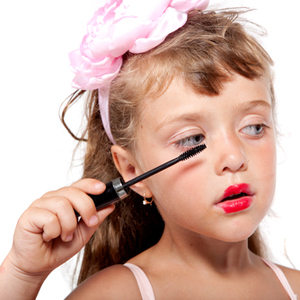
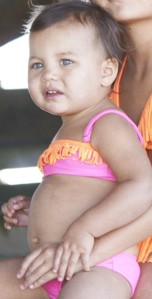
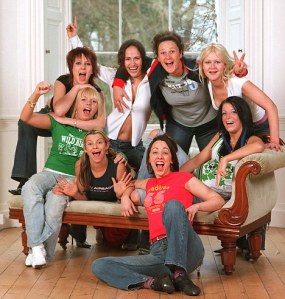
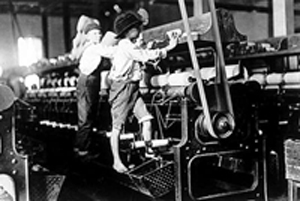

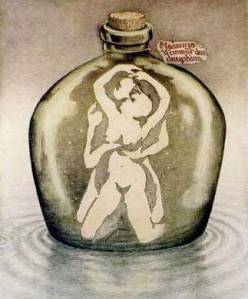
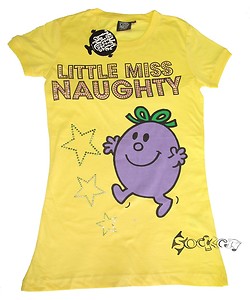
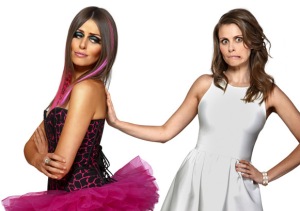
The one place where girls are DEFINATLY sexualised are child beauty pageants. A paedophilic dream come true.
Yeah they are, I hate the idea of child beauty pageants. There’s wearing glittery knickers and then there’s strutting down a catwalk in 6 inches of makeup while your parents proudly watch
It’s almost like they want to pimp out their girls… Poor girls ending up so neurotic and believing that their looks are all they have of any worth.
That’s the thing, society encouraging girls to be sexy is one thing, but when it’s their own parents instilling them with values that are at best going to lead to an extremely shallow and distorted view of society and at worst crippling self-esteem issues, there’s no hope.
Several of the girls I went to school with now have children, some have a long list of sexual partners and a few have only been with a couple if any men.
This is not my way of saying I’m better than everyone else, I’m just saying I wore the same clothes as these girls, followed the same embarrassing hair and makeup trends to try and impress the boys in year 11, hung around in the same places, listened to the same music (I’ll take you to the Candy Shop, na na na na!) and idolised the same celebrities (ahem, Britney circa 2003).
This media sexualisation was around 10 years ago and I assume it’s been around a lot longer. The only difference is there wasn’t SOCIAL media for all the so called experts (Anna Richardson… really?) to put there face to an idea and call it their own.
Was any research or statistics used in Richardson’s programme?